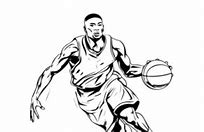Introduction to Basketball Art
Drawing:cul23ybyzfm= Basketball , with its dynamic movements, intense competition, and rich cultural significance, has long been a source of inspiration for artists. Drawing basketball scenes involves capturing the essence of the game, from the fluidity of a player’s dribble to the explosive moment of a slam dunk. This article explores various aspects of drawing basketball, providing tips, techniques, and insights for artists looking to bring the sport to life on paper.
Understanding the Fundamentals
Anatomy and Movement
Drawing:cul23ybyzfm= Basketball Before diving into drawing basketball scenes, it’s crucial to understand the human anatomy and how it moves. Basketball is a sport that demands agility, strength, and precision, all of which are reflected in the players’ bodies. Studying the musculature and skeletal structure helps artists depict realistic and dynamic poses. Pay attention to how muscles contract and relax during different actions, such as jumping, running, or shooting. Drawing:cul23ybyzfm= Basketball
Observing the Game
Drawing:cul23ybyzfm= Basketball Observation is key to capturing the authenticity of basketball. Watching games, whether live or recorded, provides a wealth of reference material. Notice the different stances, the way players interact, and the emotions displayed on their faces. Take note of the uniforms, sneakers, and other gear that adds to the overall aesthetic. By immersing yourself in the sport, you’ll gain a deeper understanding of the subtleties that make basketball unique. Drawing:cul23ybyzfm= Basketball
Essential Techniques for Drawing Basketball
Gesture Drawing
Drawing:cul23ybyzfm= Basketball Gesture drawing is an effective way to capture the movement and energy of basketball players. This technique involves making quick, loose sketches that emphasize the action rather than the details. Gesture drawing helps in understanding the flow of the body and the overall composition of the scene. Practice drawing players in various poses, focusing on the lines of action and the weight distribution. Drawing:cul23ybyzfm= Basketball
Detailing and Refinement
Once you have the basic gesture down, you can start adding details and refining your drawing. Focus on the proportions and anatomical accuracy. Use reference images to ensure that the details, such as the folds in the clothing or the grip on the basketball, are correct. Pay attention to the facial expressions and the intensity in the players’ eyes, as these elements convey the emotions of the game.
Shading and Lighting
Shading and lighting are crucial in bringing your basketball drawings to life. Understand the light source in your scene and how it affects the players and the environment. Use shading to create depth and volume, highlighting the muscular definition and the texture of the clothing. Experiment with different shading techniques, such as hatching or cross-hatching, to achieve the desired effect.
Capturing Iconic Basketball Moments
The Slam Dunk
Drawing:cul23ybyzfm= Basketball The slam dunk is one of the most iconic and exciting moments in basketball. To capture this moment, focus on the explosive power and the height of the jump. Emphasize the extension of the arms and legs, and the grip on the basketball. The expression of determination on the player’s face adds to the intensity of the scene. Don’t forget to include the reaction of the crowd, as it amplifies the excitement. Drawing:cul23ybyzfm= Basketball
The Three-Point Shot
Another thrilling moment in basketball is the three-point shot. This requires precision and a sense of timing. When drawing this scene, pay attention to the player’s form, the angle of the arms, and the follow-through. The background can include the defenders trying to block the shot and the anticipation of the spectators. Capturing the arc of the basketball as it heads toward the hoop adds a dynamic element to the drawing.
The Defensive Play
Defensive plays are just as important and exciting as offensive ones. Drawing a player blocking a shot or stealing the ball involves understanding the interactions between players. Focus on the tension in the muscles, the positioning of the hands and feet, and the intensity in the eyes. Highlight the physicality and the strategic aspect of the defense, which is often underrepresented in basketball art.
Incorporating Background Elements
The Basketball Court
The basketball court is more than just a backdrop; it sets the stage for the action. Pay attention to the details of the court, such as the markings, the texture of the floor, and the placement of the hoops. Including elements like the scoreboard, benches, and audience adds context and realism to your drawing. The court’s perspective can also enhance the composition, guiding the viewer’s eye toward the main action.
The Crowd and Atmosphere
The atmosphere of a basketball game is electric, with the crowd’s energy playing a significant role. Including the audience in your drawings can add vibrancy and excitement. Capture the diversity of expressions, from the elation of a successful play to the disappointment of a missed shot. The crowd can also provide a sense of scale and depth, making the scene more immersive.
Digital Tools for Basketball Art
Digital Drawing Tablets
For those who prefer digital art, drawing tablets offer a range of tools and features that can enhance your basketball drawings. Tablets like the Wacom or iPad Pro provide pressure sensitivity, allowing for more precise control over lines and shading. Digital art software, such as Adobe Photoshop or Procreate, offers layers, brushes, and effects that can bring your basketball scenes to life.
3D Modeling Software
3D modeling software can be a valuable tool for creating realistic basketball drawings. Programs like Blender or Daz Studio allow you to pose 3D models in various basketball positions, providing accurate reference material. You can experiment with different angles, lighting setups, and compositions before committing to a final drawing. This approach can save time and improve the accuracy of your work.
Inspirational Basketball Artists
Kadir Nelson
Kadir Nelson is a renowned artist known for his powerful and emotive depictions of African American culture, including basketball. His work often features larger-than-life figures and vibrant colors, capturing the spirit and intensity of the game. Studying Nelson’s techniques and compositions can provide valuable insights into how to convey the energy and emotion of basketball.
Patrick Ewing Jr.
Patrick Ewing Jr., the son of NBA legend Patrick Ewing, is an artist who combines his love for basketball with his artistic talent. His work often features iconic basketball moments and players, rendered in a dynamic and expressive style. Ewing’s art emphasizes the movement and athleticism of basketball, making it a great source of inspiration for aspiring basketball artists.
Conclusion: The Joy of Drawing Basketball
Drawing basketball is a rewarding endeavor that combines technical skill with a passion for the sport. Whether you’re a seasoned artist or a beginner, capturing the essence of basketball on paper requires observation, practice, and a deep appreciation for the game. By understanding the fundamentals, experimenting with techniques, and drawing inspiration from iconic moments and artists, you can create dynamic and engaging basketball art that resonates with viewers.
Drawing basketball scenes not only hones your artistic skills but also allows you to celebrate and share the excitement of the game. So grab your sketchbook, watch a game, and start drawing. Whether you’re depicting the thrill of a slam dunk, the precision of a three-point shot, or the intensity of a defensive play, each drawing is an opportunity to capture the heart and soul of basketball.
4o






